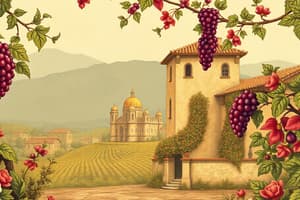Podcast
Questions and Answers
How is Coca-Cola perceived by critics of the United States?
How is Coca-Cola perceived by critics of the United States?
- As an agent of capitalism and hegemony (correct)
- As a symbol of local culture
- As a leader in ethical marketing
- As beneficial for global trade
What does the American embodiment represent for those who approve of the United States?
What does the American embodiment represent for those who approve of the United States?
- Global homogenization of cultures
- Nationalism and isolationism
- Economic and political freedom of choice (correct)
- Authoritarian control of corporations
What was General Konstantinovich Zhukov known for during his time in the Soviet Union?
What was General Konstantinovich Zhukov known for during his time in the Soviet Union?
- Advocating for consumerism
- Promoting American brands
- Being a staunch ally of Joseph Stalin
- Disagreeing with Joseph Stalin (correct)
What was a common sentiment regarding Pepsi during the Cold War?
What was a common sentiment regarding Pepsi during the Cold War?
What does the American dream symbolize for proponents of American values?
What does the American dream symbolize for proponents of American values?
During which period was wine first produced?
During which period was wine first produced?
What does the term 'Convivium' refer to in Roman culture?
What does the term 'Convivium' refer to in Roman culture?
What was a common practice regarding wine consumption in ancient Greece?
What was a common practice regarding wine consumption in ancient Greece?
What was Posca made from?
What was Posca made from?
Which of the following best describes the role of wine in Roman society?
Which of the following best describes the role of wine in Roman society?
What did Cato the Elder initially think about Greek influence?
What did Cato the Elder initially think about Greek influence?
What was one reason the Romans introduced wine production after displacing the Greeks?
What was one reason the Romans introduced wine production after displacing the Greeks?
How did the availability of wine change over time in the Mediterranean?
How did the availability of wine change over time in the Mediterranean?
Who is often credited with the innovation of making coffee berries into a drink?
Who is often credited with the innovation of making coffee berries into a drink?
Which company established coffee plantations in Batavia around 1690?
Which company established coffee plantations in Batavia around 1690?
What type of drink is rum associated with?
What type of drink is rum associated with?
What is a krater used for in ancient Greek symposia?
What is a krater used for in ancient Greek symposia?
Which of the following options describes Oenotria?
Which of the following options describes Oenotria?
What was the primary intent of the Molasses Act of 1733?
What was the primary intent of the Molasses Act of 1733?
Which beverage was associated with Thomas Jefferson’s preference?
Which beverage was associated with Thomas Jefferson’s preference?
What aspect of tea drinking is prominent in Japanese culture?
What aspect of tea drinking is prominent in Japanese culture?
Which European nation became most known for its tea consumption?
Which European nation became most known for its tea consumption?
What is the term used to describe the influence of Coca-Cola on local industries in France?
What is the term used to describe the influence of Coca-Cola on local industries in France?
Which component of Coca-Cola was valued for its stimulating effect by indigenous peoples in West Africa?
Which component of Coca-Cola was valued for its stimulating effect by indigenous peoples in West Africa?
What innovation did coffeehouses bring to society?
What innovation did coffeehouses bring to society?
How did tea first arrive in Europe?
How did tea first arrive in Europe?
Flashcards
American Values
American Values
Values associated with the United States, including economic and political freedom, consumerism, democracy, and the American Dream. These values are often admired by those who approve of the US, but also criticized by those who see them as promoting global capitalism and cultural homogenization.
Global Capitalism
Global Capitalism
A system of capitalism that operates on an international scale, characterized by the dominance of multinational corporations and the spread of Americanized culture.
Homogenization
Homogenization
The process of making things more alike, often leading to a loss of unique cultural features. In the context of Americanization, it refers to the spreading of American culture and values, potentially overshadowing local traditions.
Konstantin Zhukov
Konstantin Zhukov
Signup and view all the flashcards
Pepsi in the Cold War
Pepsi in the Cold War
Signup and view all the flashcards
Neolithic Origin of Wine
Neolithic Origin of Wine
Signup and view all the flashcards
Wine in Ancient Greece
Wine in Ancient Greece
Signup and view all the flashcards
Wine in Ancient Rome
Wine in Ancient Rome
Signup and view all the flashcards
Convivium vs. Symposion
Convivium vs. Symposion
Signup and view all the flashcards
Posca: Roman Soldier's Drink
Posca: Roman Soldier's Drink
Signup and view all the flashcards
What did people add to their wine?
What did people add to their wine?
Signup and view all the flashcards
Importance of Beer in Ancient Civilizations
Importance of Beer in Ancient Civilizations
Signup and view all the flashcards
Coffee's origin
Coffee's origin
Signup and view all the flashcards
Dutch dominance in coffee
Dutch dominance in coffee
Signup and view all the flashcards
French coffee trade
French coffee trade
Signup and view all the flashcards
Distillation in beverages
Distillation in beverages
Signup and view all the flashcards
Whiskey and Aqua Vitae
Whiskey and Aqua Vitae
Signup and view all the flashcards
Kill-Devil
Kill-Devil
Signup and view all the flashcards
Symposia vs. Convivium
Symposia vs. Convivium
Signup and view all the flashcards
Factors impacting wine price
Factors impacting wine price
Signup and view all the flashcards
Cylix, Oinochoe, and Krater
Cylix, Oinochoe, and Krater
Signup and view all the flashcards
Oenotria's meaning
Oenotria's meaning
Signup and view all the flashcards
Molasses Act of 1733
Molasses Act of 1733
Signup and view all the flashcards
Coffee: alternative to alcohol
Coffee: alternative to alcohol
Signup and view all the flashcards
Coffeehouses as social spaces
Coffeehouses as social spaces
Signup and view all the flashcards
Tea's impact in China
Tea's impact in China
Signup and view all the flashcards
Tea's journey to Europe
Tea's journey to Europe
Signup and view all the flashcards
Study Notes
Origins of Wine Production
- First produced during the Neolithic period (9000-4000 BCE) in the Zagros Mountains (modern Armenia and northern Iran).
- Possibly the origin reflected in the biblical story of Noah planting a vineyard.
Impact of Wine on the Mediterranean
- Introduced to Crete and Greek regions.
- Remained an elite drink, marking status.
- Became a social and religious beverage.
- Production and availability increased geographically.
Impact of Wine in Roman Society
- Romans adopted Greek culture, including wine consumption.
- Romans, initially wary of Greek influence, saw wine as a way to reconcile their agricultural values with Greek social traditions.
- Cato, initially opposed to Greek influence, later deemed wine a good bridge.
- Wine became a universal staple for the rich and poor.
Convivium
- Roman banquet where guests were served wines based on social standing.
- Distinguished from the Greek symposion, which emphasized shared drinking.
Posca
- Sour wine mixed with water, typically given to Roman soldiers.
- A form of water purification, also part of the Roman Army's daily ration.
- Possibly offered to Jesus during his crucifixion.
Staple Crop in Early Civilizations
- Sugarcane from Barbados (Caribbean colonies) introduced with equipment and knowledge from Brazil.
Beer in Ancient Times
- (Details omitted in the text)
Coffee Origins and Spread
- Yemeni innovation, often attributed to Muhamed Al-Dhabhani.
- Reached Mecca and Cairo by 1510.
- Arabia was the world's primary coffee supplier until the late 17th century.
- Dutch East India Company established coffee plantations in Java (1690).
- Dutch gained global dominance in the coffee market.
- French involvement beginning in 1730.
- Brazil became the world's leading coffee producer.
Distillation and Related Beverages
- Process of vaporizing and recondensing liquids to purify.
- Applied to wine and beer to create stronger beverages (e.g., whiskey, aqua vitae, rum).
Symposia
- Greek banquets where everyone drank from a shared vessel (krater).
- Emphasized unity and equal participation.
Wine Price and Accessibility
- Wine transportation and accessibility improved over time.
- Wine remained relatively expensive outside wine-producing regions.
- Some turned away from beer toward wine.
Cylix, Oinochoe, and Krater
- Cylix: Shallow, two-handled drinking bowl.
- Oinochoe: Wine jug.
- Krater: Large bowl for mixing wine with water.
Oenotria
- Region north of Greek colonies, meaning "land of the trained vines" under Roman rule.
Molasses Act of 1733
- Imposed a tax on molasses imported from French colonies to North American colonies to protect British sugar producers, who were losing ground to the French.
- This fostered American defiance of British laws.
Health Benefits of Spirits
- (Details omitted in the text)
Thomas Jefferson on Whiskey
- Disliked whiskey, preferring wine despite attempts to cultivate vines in America.
- Believed wine was superior, citing cost, alcohol content, and perceived American connection to whiskey.
Beverage and Political Thought
- Coffee was viewed as a sobering alternative to alcohol, fostering intellectual spaces (e.g., coffeehouses).
- Coffeehouses were meeting places for professionals (artists, sailors, musicians).
- Became a mail delivery points for regulars in a community.
Tea in China and Japan
- Emperor Shen Nung brewed the first cup of tea in China.
- Tea was originally a medicinal beverage in southwest China.
- Tea was later used by Buddhist and Taoist monks for meditation.
- Became currency in the form of bricks in China.
- Mongols preferred koumiss (similar to wine) over tea.
- Tea drinking introduced to Japan through Buddhist monks.
- Became integral to Japanese society and a ceremonial practice.
Tea Introduction to Europe
- First tea imported in 1610 by the Dutch.
- Became a novelty drink in Europe.
- Gradually became more popular in France and England.
- Initially expensive, with limited impact on the European market.
- British became the greatest tea consumers in Europe.
Upper Assam Tea
- Indigenous tea plant in Upper Assam area.
- London merchants formed the Assam Company to capitalize on it.
Coca-Colonization
- Initially used by communist sympathizers in France, causing controversy.
- (Details omitted in the text)
Coca-Cola Creation
- (Details omitted in the text)
West African Ingredients in Coca-Cola
- Kola nuts, a stimulant, valued in West Africa were incorporated into Coca-Cola.
WWII and Coca-Cola
- Coca-Cola became an American symbol during WWII.
- The brand became associated with consumerism and freedom in the USA
- Associated with political values, either positive or negative (related to capitalism, homogenization etc).
Soviet Leader and Coca-Cola
- General Zhukov, a Soviet military leader, was a rare dissenter against Stalin and enjoyed Coca-Cola.
Pepsi During the Cold War
- Pepsi was viewed as a less-desirable option during the Cold War, given the political context of the conflict.
Studying That Suits You
Use AI to generate personalized quizzes and flashcards to suit your learning preferences.




